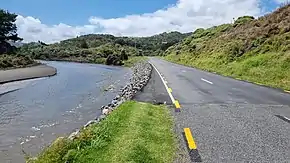Waitākere River
The Waitākere River is a river of the Auckland Region of New Zealand's North Island. It flows north then west from its sources in the Waitākere Ranges, reaching the Tasman Sea at Te Henga / Bethells Beach, to the south of Muriwai Beach. The upper reaches of the river are dammed to form the Waitākere Reservoir. The Waitākere Falls, just below the dam, are 95 metres (312 ft) high and the third highest waterfall in the North Island.[1]
| Waitākere River | |
|---|---|
 The Waitākere River near Te Henga (Bethells Beach) | |
| Location | |
| Country | New Zealand |
| Physical characteristics | |
| Mouth | |
• location | Tasman Sea |
• coordinates | 36°53′29″S 174°26′31″E |
| Length | 16 km (10 mi) |
History
The river was a central point for Te Kawerau ā Maki Māori, who originally called the lower section of the river Te Awa Kōtuku, or the White heron's Plume River, and the upper section Waikirikiri.[2] The name Te Awa Kōtuku was a reference to the Waitākere Falls.[3] The area was the most densely settled area of West Auckland,[3] and the river banks were the locations of many Te Kawerau ā Maki kāinga, such as Ōhutukawa near Lake Wainamu, Motu, Ōkaihau, Raumati, Pihāriki, Parawai, and Waitī.[2] In Te Kawerau ā Maki legend, the river is home to a malevolent taniwha named Te Mokoroa.[4]
While the river currently flows into the Tasman Sea south of Ihumoana Island at Te Henga / Bethells Beach, the river previously flowed north of the island, over-top of a rock named Waitākere ("cascading water"). The mouth of the river ("Te Puaha o Waitākere") began to be known as Waitākere during the early 18th century, after the death of an important chief whose body was laid on the rock.[3] Over time, Te Kawerau ā Maki began referring to the entire river by the name Waitākere.[3]
The upper Waitākere River was first milled for kauri timber from the 1870s, with bullock carts transporting timber to Auckland along clay tracks and barges.[4] The opening of the North Auckland railway between Auckland and Helensville in 1881 opened up the upper Waitākere River area for more intensive logging.[4] In the late 1880s, a small sawmill operated in the Waitākere River valley.[4]
During the late 19th and early 20th centuries, the Waitākere Falls was one of the most popular tourist attractions in the Waitākere Ranges, until the construction of the Waitākere Dam in 1910 severely reduced the water volume.[5] The dam was constructed to solve successive drinking water crises faced by the city of Auckland.[6] It caused a major drop in the volume of the river, stopping the river from being able to be navigated by canoe, reduced the water quality levels, and significantly affecting the availability of fish and other river resources, negatively affecting the Te Kawerau ā Maki community living along the river.[4] Between 1919 and 1925, kauri logging intensified when the Kauri Timber Company (KTC) operated along the Waitākere River valley.[4] During this period, the company operated a bush tramline along the valley.[4] In 1927, the height of the Waitakere Dam was increased, which increased the size of the Waitakere Reservoir and flooded the original site of Waitī.[2]
See also
References
- "Waitakere waterfalls". New Zealand Waterfalls. Retrieved 31 March 2014.
- "Te Kawerau ā Maki Deed of Settlement Schedule" (PDF). New Zealand Government. 22 February 2014. Retrieved 29 January 2021.
- Murdoch, Graeme (1990). "Nga Tohu o Waitakere: the Maori Place Names of the Waitakere River Valley and its Environs; their Background History and an Explanation of their Meaning". In Northcote-Bade, James (ed.). West Auckland Remembers, Volume 1. West Auckland Historical Society. pp. 17–26. ISBN 0-473-00983-8.
- Waitākere Ranges Local Board (October 2015). "Local Area Plan: Te Henga (Bethells Beach) and the Waitākere River Valley. Waitākere Ranges Heritage Area" (PDF). Auckland Council. ISBN 978-0-908320-17-2. Retrieved 15 May 2022.
- Northcote-Bade, James (1990). "Adres Reischek's Visit to the Waitakere Ranges". In Northcote-Bade, James (ed.). West Auckland Remembers, Volume 1. West Auckland Historical Society. p. 60. ISBN 0-473-00983-8.
- La Roche, John (2011). "Auckland's Water Supply". In La Roche, John (ed.). Evolving Auckland: The City's Engineering Heritage. Wily Publications. pp. 27–50. ISBN 9781927167038.